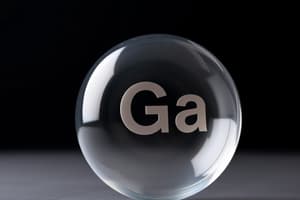Podcast
Questions and Answers
What are the variables in the ideal gas law equation?
What are the variables in the ideal gas law equation?
P (pressure), V (volume), n (number of moles), R (gas constant), T (temperature)
What does it mean for a gas to behave ideally?
What does it mean for a gas to behave ideally?
Gas particles have no volume and no intermolecular forces, and they move rapidly and randomly
How are real gases and ideal gases related?
How are real gases and ideal gases related?
Real gases behave LIKE ideal gases at normal temperatures and normal pressures
What is the gas constant?
What is the gas constant?
What does the ideal gas law relate?
What does the ideal gas law relate?
What can the ideal gas law equation be used to calculate?
What can the ideal gas law equation be used to calculate?
What is the ideal gas equation and what do the variables represent?
What is the ideal gas equation and what do the variables represent?
How are pressure and temperature related?
How are pressure and temperature related?
How are pressure and the number of particles related?
How are pressure and the number of particles related?
How are volume and the number of particles related?
How are volume and the number of particles related?
What is the relationship between pressure, volume, number of particles, and temperature described by the ideal gas law?
What is the relationship between pressure, volume, number of particles, and temperature described by the ideal gas law?
What is the value of the ideal gas constant (R) in the ideal gas equation?
What is the value of the ideal gas constant (R) in the ideal gas equation?
Flashcards are hidden until you start studying




